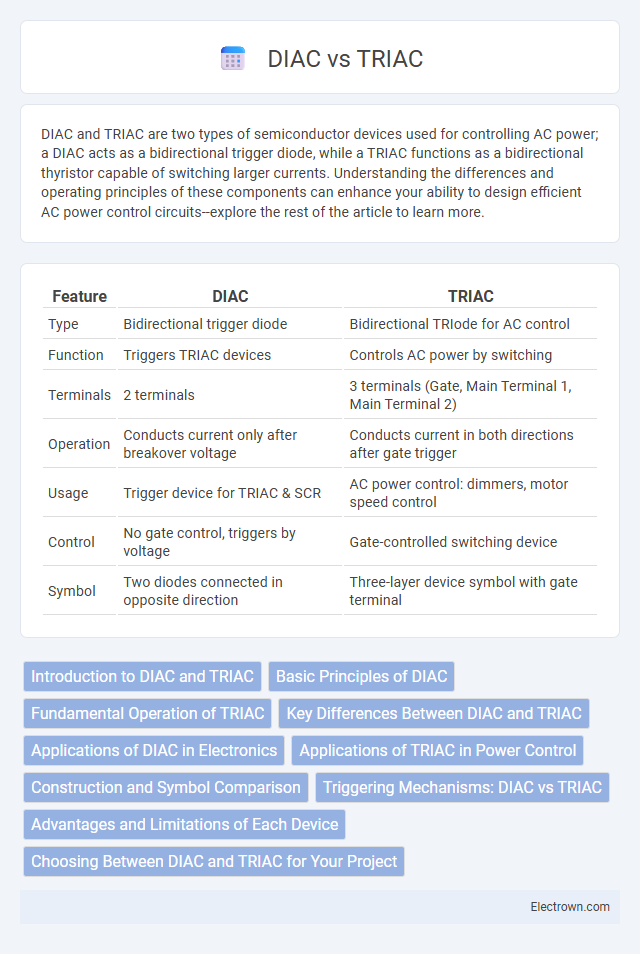DIAC and TRIAC are two types of semiconductor devices used for controlling AC power; a DIAC acts as a bidirectional trigger diode, while a TRIAC functions as a bidirectional thyristor capable of switching larger currents. Understanding the differences and operating principles of these components can enhance your ability to design efficient AC power control circuits--explore the rest of the article to learn more.
Table of Comparison
| Feature | DIAC | TRIAC |
|---|---|---|
| Type | Bidirectional trigger diode | Bidirectional TRIode for AC control |
| Function | Triggers TRIAC devices | Controls AC power by switching |
| Terminals | 2 terminals | 3 terminals (Gate, Main Terminal 1, Main Terminal 2) |
| Operation | Conducts current only after breakover voltage | Conducts current in both directions after gate trigger |
| Usage | Trigger device for TRIAC & SCR | AC power control: dimmers, motor speed control |
| Control | No gate control, triggers by voltage | Gate-controlled switching device |
| Symbol | Two diodes connected in opposite direction | Three-layer device symbol with gate terminal |
Introduction to DIAC and TRIAC
DIAC and TRIAC are semiconductor devices commonly used in AC power control applications such as light dimmers and motor speed controllers. A DIAC is a bidirectional trigger diode that conducts current only after its breakover voltage is reached, serving as a switch to trigger TRIACs. TRIAC, or Triode for Alternating Current, can conduct current in both directions when triggered, allowing effective control of AC power in your electronic circuits.
Basic Principles of DIAC
DIACs operate as bidirectional trigger devices with two terminals, exhibiting symmetrical breakover voltages in both polarities, making them ideal for triggering TRIACs in AC circuits. They do not have a gate terminal and switch to a low-resistance state only after the applied voltage exceeds the breakover threshold, allowing controlled conduction. DIACs are commonly used in light dimmers, motor speed controls, and phase control applications due to their ability to provide precise triggering signals.
Fundamental Operation of TRIAC
The fundamental operation of a TRIAC involves controlling AC power by allowing current flow in both directions when triggered. Unlike a DIAC, which is a bidirectional trigger device without gate control, a TRIAC features a gate terminal that enables precise control of the switching point in the AC cycle. This capability makes TRIACs essential for applications such as dimmers, motor speed controls, and AC switching circuits.
Key Differences Between DIAC and TRIAC
DIAC and TRIAC differ primarily in their structure and functionality; DIAC is a bidirectional trigger diode used to initiate TRIAC operation by providing a sudden voltage drop, whereas TRIAC acts as a bidirectional switch capable of conducting current in both directions. TRIAC can handle higher power loads and is commonly used in AC power control applications like dimmers and motor speed controls, while DIAC serves mainly as a triggering device within these circuits. Understanding these key differences helps you select the appropriate component for efficient AC power regulation and switching.
Applications of DIAC in Electronics
DIACs are commonly used in triggering circuits for TRIACs, providing a stable and symmetrical breakover voltage ideal for phase control in light dimmers and motor speed regulators. Their bidirectional conduction capability helps improve the reliability and performance of AC switching devices in electronic appliances. DIACs also play a crucial role in reducing electrical noise and ensuring smoother switching in AC power control applications.
Applications of TRIAC in Power Control
TRIACs are widely used in power control applications such as dimming lights, controlling electric motor speeds, and regulating heating elements in household appliances. Their ability to conduct current in both directions allows efficient AC power switching and phase control in devices like fan speed controllers and solid-state relays. Compared to DIACs, which primarily serve as triggering devices, TRIACs provide direct load control, making them essential components in modern AC power management systems.
Construction and Symbol Comparison
DIAC is a bidirectional trigger diode with two terminals and a symmetrical, breakover voltage characteristic, commonly used to trigger TRIACs. TRIAC consists of three terminals (MT1, MT2, and gate) and is designed for controlling AC power by conducting current in both directions after triggering. Understanding the distinct symbols, where DIAC is shown as a two-terminal device with no gate and TRIAC as a three-terminal device including a gate terminal, helps you identify their roles in AC switching circuits.
Triggering Mechanisms: DIAC vs TRIAC
The DIAC triggers by reaching a specific breakover voltage, allowing current to flow in either direction without a gate terminal. A TRIAC, however, has a gate terminal that triggers conduction at lower voltages, providing controlled switching in both directions. Your choice between DIAC and TRIAC depends on whether precise triggering or simple bidirectional control is required.
Advantages and Limitations of Each Device
DIACs offer precise triggering for symmetrical AC switching, making them ideal for light dimmers and small motor controls but have limited current handling capacity and no gate terminal for external triggering. TRIACs provide greater current control versatility with gate triggering, enabling modulation of power in AC circuits and operation in all four quadrants; however, they can generate higher electromagnetic interference and require snubber circuits to prevent false triggering. While DIACs excel in simplicity and reliable breakover voltage triggering, TRIACs dominate in applications demanding variable power control but involve more complex triggering and protection mechanisms.
Choosing Between DIAC and TRIAC for Your Project
Choosing between DIAC and TRIAC depends on the control complexity and load requirements of your project; DIACs serve as trigger devices typically used to initiate TRIACs in AC circuits for smooth switching. TRIACs handle the main power switching for AC loads, providing bidirectional control and greater current capacity compared to DIACs. For precise phase control and high-power applications, TRIACs are preferred, while DIACs are suited for simple trigger functions in dimmers and motor speed controls.
DIAC vs TRIAC Infographic

 electrown.com
electrown.com